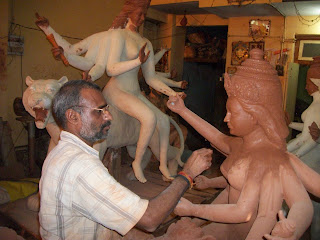“I am working tirelessly for last 23 years. Everyday, I wake up in the morning and start working. I don't stop for 15 to 18 hours. With shooting, promotional events, television programmes, awards functions and dance tours, I feel like the real Shah Rukh has got lost somewhere. I don't understand when I start acting in real life as I don't stop acting on reel,” confessed Shah Rukh.
This thoughtful confession from a Mega Star was also a reflection of the mood with which he began his day on Wednesday. His ‘tweet’ early in the day said - ‘Been a long time since I spent some time with myself. Enroute to Nagpur...the tour begins for the DON 2.’
“I have a special attachment and respect for women. I lost my father at a very tender age and my mother looked after me. After her, my elder sister, then my wife and now my daughter - all these women have made my life very beautiful,” he said, before he signed a ‘Save Girl Child’ placard for Lokmat Sakhi Manch.
SRK answered many questions that he frequently faces (how did he feel playing negative role in DON series). He also spoke about his heroines and attributed 60 percent of his success to them. “Right from Juhi and Madhuri to Kajol and Rani, to Deepika and Priyanka, everyone is special for me. And Gauri is the ‘specialest’,” he said receiving an enthusiastic applause from his listeners.
Shah Rukh amply demonstrated why was he such a heartthrob as he danced with a school kid on DON 2 title song. Before he left the event, he advised students to study hard ‘as education is the only way to make country a super power.’ Earlier, Jyotsna Darda, President of Sakhi Manch, welcomed Shah Rukh.
After working 15-hours a day for more than two decades, Shah Rukh Khan says, his original persona has lost somewhere
in the middle...
RAHUL, Raj, G-One or Mohan Bhargav - which character resembles most with the personality of Shah Rukh Khan as a human being? - a profound question from a college-going girl turned King Khan quite philosophical and the candid SRK confessed that he faces personality conflict these days.
“I am working tirelessly for last 23 years. Everyday, I wake up in the morning and start working. I don't stop for 15 to 18 hours. With shooting, promotional events, television programmes, awards functions and dance tours, I feel like the real Shah Rukh has got lost somewhere. I don't understand when I start acting in real life as I don't stop acting on reel,” confessed Shah Rukh.
This thoughtful confession from a Mega Star was also a reflection of the mood with which he began his day on Wednesday. His ‘tweet’ early in the day said - ‘Been a long time since I spent some time with myself. Enroute to Nagpur...the tour begins for the DON 2.’
In Nagpur, SRK addressed a press conference at Cinemax Theatre, and then came for a ‘Coffee With Shah Rukh’ event organised by Lokmat Media Group at Hotel Centre Point, Ramdaspeth. Here, he interacted with members of Lokmat ‘YuvaNext’, ‘Sakhi Manch’ and a large number of school students (most of them his die-hard fans) who gathered to see him. As Lokmat group works for several social causes, issues like ‘Save Girl Child’, and ‘Education’ and ‘Sports’ were elaborately mentioned during the event and SRK's views of these issues made the event very engaging for all.
“I have a special attachment and respect for women. I lost my father at a very tender age and my mother looked after me. After her, my elder sister, then my wife and now my daughter - all these women have made my life very beautiful,” he said, before he signed a ‘Save Girl Child’ placard for Lokmat Sakhi Manch.
Being a sports person at heart, it was quite obvious for Shah Rukh to speak about sports activity, especially, football, as Nagpur recently hosted second season of NPL football tournament. “I am glad to know that football is being promoted by corpote houses of Nagpur, in this part of the country. I used to play football during my college days. I dream of a day when India will qualify for FIFA World Cup. Star players will emerge from such League tournaments,” Shah Rukh said with a promise that he will come to Nagpur for NPL’s next season.
SRK answered many questions that he frequently faces (how did he feel playing negative role in DON series). He also spoke about his heroines and attributed 60 percent of his success to them. “Right from Juhi and Madhuri to Kajol and Rani, to Deepika and Priyanka, everyone is special for me. And Gauri is the ‘specialest’,” he said receiving an enthusiastic applause from his listeners.
Shah Rukh amply demonstrated why was he such a heartthrob as he danced with a school kid on DON 2 title song. Before he left the event, he advised students to study hard ‘as education is the only way to make country a super power.’ Earlier, Jyotsna Darda, President of Sakhi Manch, welcomed Shah Rukh.
 |
| Cutting of the same article appeared in The Hitavada on December 15, 2011 |






































